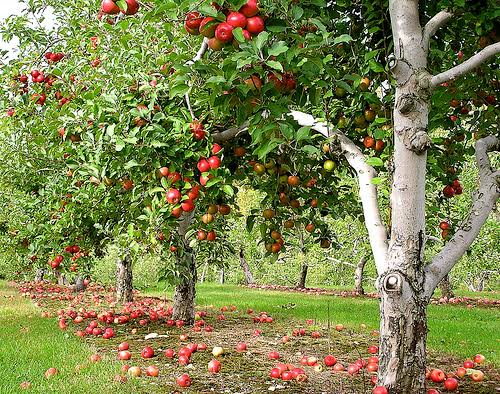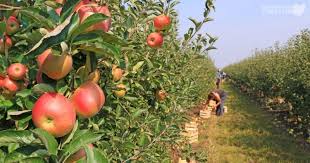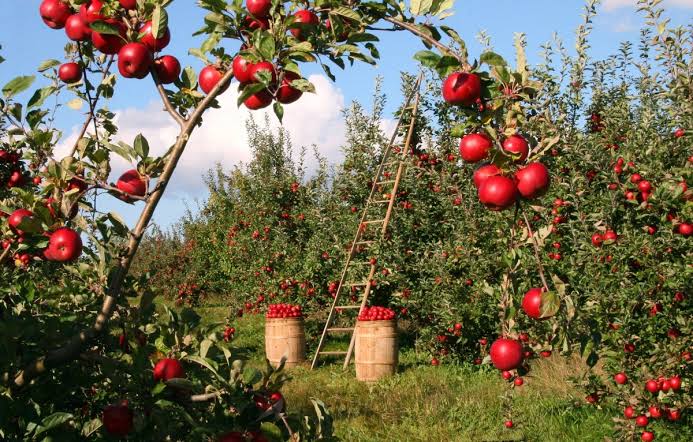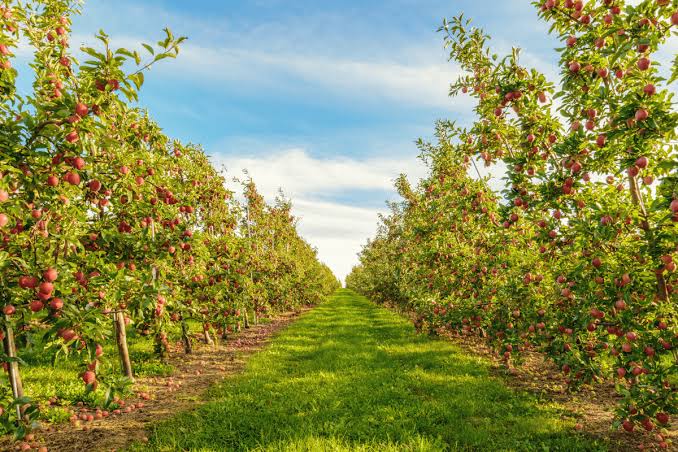Apple orchards are wonderful places filled with apple trees. These trees grow apples, the delicious fruits that many people enjoy eating. Apple orchards can be found in various parts of the world, where the climate is suitable for apple tree cultivation.
In an apple orchard, you will see rows and rows of apple trees. These trees are carefully planted, allowing enough space for them to grow and bear fruit. Apple orchards are often visited by farmers and workers who take care of the trees throughout the year. They make sure the soil is healthy, water the trees, and protect them from pests.
During the spring, apple orchards come alive with the beauty of blossoming flowers on the apple trees. These blossoms eventually turn into small, green apples. As the seasons progress, these apples grow bigger and change color, indicating that they are ripe and ready to be harvested.
Harvest time is an exciting period in an apple orchard. Farmers and workers gather to pick the ripe apples from the trees. They use ladders to reach the higher branches, carefully collecting each apple by hand. The apples are then sorted based on their size and quality. Some orchards even have special machines to assist in the harvesting process.
Once the apples are picked, they are collected in baskets and transported to storage facilities. These facilities are designed to keep the apples fresh for an extended period. Apples from the orchard can be sold in local markets, grocery stores, or used to make various apple products like apple pies, applesauce, and apple juice.
Visiting an apple orchard can be a delightful experience for families. Many orchards offer the opportunity for people to pick their own apples. Families can spend a day outdoors, enjoying the fresh air and the experience of harvesting apples together. Some orchards also have additional attractions, such as hayrides, petting zoos, and apple tasting sessions.
Apple orchards play a vital role in the agricultural industry, providing a significant source of apples that contribute to various food products. The cultivation of apple trees requires careful attention to detail, from planting to harvesting, ensuring a bountiful yield of delicious apples. Overall, apple orchards are not just places where apples grow; they are vibrant, dynamic environments that bring joy to those who visit and contribute to the flavors we savor in countless apple-based delights.
In addition to their agricultural importance, apple orchards also contribute to the beauty of rural landscapes. The sight of rows of apple trees, especially when in full bloom, creates a picturesque scene that attracts both locals and tourists. Many people find solace in strolling through the orchards, appreciating the natural beauty and tranquility that these places offer.
The diversity of apple varieties found in orchards adds to the richness of the experience. Different types of apples, each with its unique flavor and texture, thrive in these orchards. From sweet and crisp varieties to those with a tart taste, apple orchards showcase a spectrum of flavors that cater to various preferences.
Beyond the visual and gustatory delights, apple orchards also have ecological benefits. They contribute to biodiversity by providing habitats for various insects, birds, and other wildlife. Bees, in particular, play a crucial role in pollinating the apple blossoms, ensuring a successful fruiting season. This interdependence highlights the intricate balance within ecosystems and underscores the importance of preserving these orchards for both agricultural and environmental reasons.
Throughout the changing seasons, apple orchards undergo a transformation that mirrors the cycle of life. From the dormant winter months when trees rest, to the vibrant spring with blossoms heralding new beginnings, and finally to the fruitful autumn harvest, each stage has its own charm. Orchards become living testimonials to the passage of time, connecting people to the natural rhythm of the Earth.
In some regions, apple orchards also become cultural hubs. Festivals celebrating the apple harvest are common, bringing communities together to enjoy the bounty of the season. These events often include activities like apple picking contests, cider pressing demonstrations, and traditional folk music. Such celebrations foster a sense of community and shared appreciation for the agricultural heritage that apple orchards represent.
As society becomes more conscious of sustainable practices, apple orchards are adapting. Many orchards are implementing eco-friendly techniques, such as organic farming methods and integrated pest management, to minimize environmental impact. These efforts reflect a commitment to preserving not only the tradition of apple cultivation but also the health of the surrounding ecosystems.
However, apple orchards are not just places where apples are grown; they are living, breathing entities that weave together agriculture, nature, and culture. Their significance extends far beyond the boundaries of the orchard itself, reaching into our homes through the apples we enjoy and the memories we create during visits. In essence, apple orchards embody the harmonious relationship between humanity and nature, showcasing the beauty and abundance that arise when we work in tandem with the environment.
Read Also: Boston Terrier: Description, Origin, Health and Complete Care Guide
Growing and Care Guide of Apple Orchards

Growing and caring for apple orchards require attention to detail and a commitment to nurturing healthy trees. Here’s a guide to help you cultivate a thriving apple orchard:
1. Site Selection:
Sunlight: Choose a location that receives full sunlight, as apples thrive in sunlight for most of the day.
Well-Drained Soil: Ensure the soil has good drainage to prevent waterlogging, which can harm the roots.
2. Planting:
Spacing: Plant apple trees with adequate spacing to allow for proper air circulation and sunlight exposure.
Variety Selection: Choose apple varieties that are well-suited to your climate and soil conditions.
Planting Depth: Plant trees at the same depth as they were in the nursery, and water thoroughly after planting.
3. Watering:
Consistent Moisture: Maintain consistent soil moisture, especially during dry spells. Irrigate regularly but avoid waterlogged conditions.
Mulching: Apply a layer of mulch around the base of the trees to retain moisture and suppress weeds.
4. Pruning:
Annual Pruning: Prune trees annually during the dormant season to remove dead or diseased branches and shape the canopy.
Thinning: Thin out excess fruit to promote larger and healthier apples and prevent branches from breaking under the weight.
5. Pest and Disease Management:
Monitoring: Regularly inspect trees for signs of pests and diseases. Early detection allows for effective control measures.
Integrated Pest Management (IPM): Implement IPM strategies, which may include biological controls, organic sprays, and cultural practices to minimize chemical usage.
6. Fertilization:
Soil Testing: Conduct soil tests to determine nutrient levels. Adjust fertilization based on the specific needs of your orchard.
Timing: Apply fertilizer in early spring before new growth begins, and avoid late-season fertilization.
7. Harvesting:
Timing: Harvest apples when they reach the desired size, color, and taste. Different varieties have distinct ripening times.
Gentle Handling: Handle harvested apples gently to avoid bruising, which can reduce their shelf life.
8. Storage:
Cool, Dark Storage: Store apples in a cool, dark place to extend their shelf life. Refrigeration is ideal for long-term storage.
Checking Regularly: Periodically check stored apples for any signs of spoilage, and remove any damaged ones to prevent affecting others.
9. Seasonal Considerations:
Winter Protection: Provide winter protection by wrapping the base of young trees with tree guards to prevent rodent damage.
Blossom Protection: In areas prone to late spring frosts, consider measures to protect blossoms, such as covering trees with frost blankets.
Importance of Apple Orchards

The importance of apple orchards extends across various dimensions, ranging from economic significance to environmental contributions and cultural value.
1. Economic Importance:
Commercial Value: Apple orchards are major contributors to the agricultural economy. They yield a significant portion of the world’s apple production, generating income for farmers and supporting local economies.
Employment Opportunities: Orchards create employment opportunities, from planting and maintenance to harvesting and processing. This helps sustain rural communities and provides jobs for a diverse range of skills.
2. Environmental Contributions:
Biodiversity: Orchards contribute to biodiversity by providing habitats for insects, birds, and other wildlife. They form part of a broader ecosystem that supports various species.
Oxygen Production: Like all trees, apple orchards play a role in producing oxygen, helping to improve air quality and mitigate the impact of climate change.
Carbon Sequestration: Apple trees, through the process of photosynthesis, absorb carbon dioxide from the atmosphere, helping to sequester carbon and reduce greenhouse gas levels.
3. Nutritional and Health Benefits:
Nutrient-Rich Fruits: Apples are a rich source of essential nutrients, including dietary fiber, vitamins, and antioxidants. They contribute to a healthy diet and can help prevent certain illnesses.
Diverse Culinary Uses: Apples are versatile in the kitchen, used in a wide range of culinary creations from pies and crisps to salads and sauces. Their versatility adds nutritional value and flavor to various dishes.
4. Cultural and Recreational Significance:
Traditions and Festivals: Apple orchards are often associated with cultural traditions and festivals celebrating the harvest season. These events foster community spirit and provide opportunities for cultural exchange.
Recreational Enjoyment: Orchards serve as recreational spaces, offering families a chance to enjoy nature, pick their own apples, and participate in activities such as hayrides or apple tastings.
5. Educational Value:
Learning Opportunities: Orchards provide an educational environment where people can learn about agriculture, horticulture, and the lifecycle of trees. Educational programs hosted in orchards can promote environmental awareness and sustainable practices.
6. Sustainable Agriculture:
Sustainable Practices: Apple orchards can serve as models for sustainable agricultural practices. Implementing organic farming methods, integrated pest management, and soil conservation techniques demonstrates a commitment to environmental stewardship.
In essence, apple orchards play a multifaceted role in our lives, contributing to the economy, environment, health, and culture. Their importance extends beyond the production of a popular fruit, embodying a harmonious connection between agriculture and the well-being of communities and ecosystems.
Read Also: English Bulldog: Description, Health and Origin
Where to Find Orchards near Me/You

Orchards, where fruit trees are cultivated, can be found in various locations, ranging from rural areas to more urban settings. Here are some common places where you might find or locate orchards:
1. Rural Agricultural Regions: Orchards are frequently located in rural areas with suitable climates and fertile soil. Regions known for agriculture, such as the countryside, often have extensive orchards producing a variety of fruits like apples, cherries, peaches, and more.
2. Fruit-Growing Regions: Specific areas are renowned for growing particular fruits due to favorable climate conditions. For example, you might find citrus orchards in warmer climates, while apple orchards are common in cooler regions.
3. Farms and Agricultural Estates: Many orchards are part of larger farms or agricultural estates. These areas can be privately owned or open to the public, offering a chance to explore and even pick your own fruits during the harvest season.
4. Tourist Destinations: Orchards in scenic locations may become tourist destinations, especially during the fruit-bearing season. Some orchards offer guided tours, tastings, and other activities for visitors.
5. Community Orchards: In urban and suburban areas, community orchards are becoming more popular. These are often managed by local communities or organizations and can be found in parks, community gardens, or designated public spaces.
6. Botanical Gardens: Botanical gardens may have sections dedicated to fruit trees and orchard plants. These curated spaces showcase different varieties of fruit-bearing trees and can be educational and aesthetically pleasing.
7. Educational Institutions: Some schools, universities, and research institutions have orchards for educational and research purposes. These orchards may focus on specific fruit varieties and serve as learning centers.
8. Fruit Festivals and Events: During fruit festivals and events, local orchards may open their doors to the public. These occasions often include activities like orchard tours, tastings, and opportunities to purchase fresh fruits.
9. Online Directories and Apps: There are online resources and mobile apps dedicated to helping people find orchards in their vicinity. These platforms may provide information on types of fruits grown, harvest seasons, and visiting opportunities.
When looking for orchards, consider the type of fruit you’re interested in, the geographical region, and the time of year. Orchards are often most vibrant during the harvest season, so plan your visit accordingly. Always be mindful of any guidelines or regulations set by the orchard owners when exploring these spaces.
Read Also: Air Microbiology and Causes of Air-Borne Diseases

